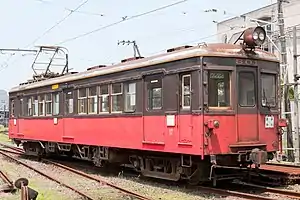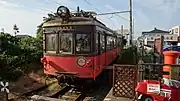| Choshi Electric Railway 800 series | |
|---|---|
 DeHa 801 at Nakanocho Depot in July 2010 | |
| In service | 1986–September 2010 |
| Manufacturer | Teikoku Sharyo |
| Constructed | 1950 |
| Refurbished | February 1986 |
| Number built | 1 vehicle |
| Number in service | None |
| Formation | Single car |
| Fleet numbers | DeHa 801 |
| Capacity | 120 (40 seated) |
| Operators | Choshi Electric Railway |
| Depots | Nakanochō |
| Specifications | |
| Car body construction | Steel |
| Car length | 16,210 mm (53 ft 2 in) |
| Width | 2,700 mm (8 ft 10 in) |
| Height | 4,033 mm (13 ft 2.8 in) |
| Doors | 3 per side |
| Weight | 28.2 t |
| Traction system | MB-64-C (48.49 kW x4) |
| Power output | 194 kW |
| Electric system(s) | 600 V DC overhead wire |
| Current collector(s) | PS13 pantograph (x1) |
| Bogies | Nippon Sharyo D-16 |
| Track gauge | 1,067 mm (3 ft 6 in) |
The Choshi Electric Railway 800 series (銚子電鉄800形, Chōshi Dentetsu 800-gata) was an electric multiple unit (EMU) train type operated by the private railway operator Choshi Electric Railway in Chiba Prefecture, Japan, between 1986 and September 2010.[1]
Build details
| No. | Former No. | Manufacturer | Build date | Conversion date | Withdrawal date |
|---|---|---|---|---|---|
| DeHa 801 | MoHa 106 | Teikoku Sharyo | 1950 | 12 February 1986 | September 2010 |
Interior
The train had longitudinal seating and was equipped with fare collection boxes at each end for wanman driver only operation. It was not equipped with air-conditioning.
 Interior view of DeHa 801, November 2009
Interior view of DeHa 801, November 2009
History
One single car was converted in February 1986 from former Iyo Railway 100 series car MoHa 106, purchased in October 1985. This car was built in 1950 by Teikoku Sharyo as KuHa 405, and converted to become single-car MoHa 106 with an additional driving cab in 1961.[3] The second driving cab was subsequently taken out of use and a gangway door added, but from 1967, the driving cab was reinstated, with the gangway door left in place.[3]
Conversion for use on the Choshi Electric Railway involved sealing the gangway in the later added cab end (at the Tokawa end), and replacement of the original Hitachi MIC bogies with Nippon Sharyo D-16 type bogies.[1]
 Iyo Railway MoHa 103 (car of the same type) shortly before withdrawal in 1984
Iyo Railway MoHa 103 (car of the same type) shortly before withdrawal in 1984 Nippon Sharyo D-16 bogie, July 2010
Nippon Sharyo D-16 bogie, July 2010
The car was repainted in 1990 from the earlier red and cream livery to the "new" Choshi Electric Railway livery of brown and red.[1]
It was withdrawn after its final day of operation on 23 September 2010,[4] and was then used for a time as a maintenance vehicle for inspection of overhead power lines.[5] It was initially stored in the loop next to Tokawa Station before being moved to storage behind Kasagami-Kurohae Station.[6] From 1 May 2015, parked next to Tokawa Station, the car was used to house the Keiyo Towa Pharmaceutical Shōwa Nostalgia Museum, containing exhibits of toys and everyday items from the Shōwa period (1925–1989).[5][7] The exhibits were removed in August 2017, and the train interior returned to the state from its time in operation.[5]
 DeHa 801 viewed from the up (Choshi) end in July 2010
DeHa 801 viewed from the up (Choshi) end in July 2010 Withdrawn DeHa 801 stored next to Tokawa Station in January 2012
Withdrawn DeHa 801 stored next to Tokawa Station in January 2012 Withdrawn DeHa 801 as the Keiyo Towa Pharmaceutical Shōwa Nostalgia Museum at Tokawa Station in October 2015
Withdrawn DeHa 801 as the Keiyo Towa Pharmaceutical Shōwa Nostalgia Museum at Tokawa Station in October 2015
Exposed to the elements, by 2017 the car body had corroded significantly due to rust, to the extent that there were holes in places.[8] A restoration project was launched, in which two commercial sponsors donated materials and labor for rust treatment, bodywork repair and subsequent repainting with rust-proof paint. Students from the local Choshi Commercial Senior High School assisted with the restoration work. After completion of the repairs, the car was unveiled and reopened to the public on 23 December 2017, with a two-week exhibition of photographs from its time in operation.[9]
 DeHa 801 in April 2019, post-restoration
DeHa 801 in April 2019, post-restoration Restored car interior, April 2019
Restored car interior, April 2019
References
- 1 2 3 4 Satō, Toshio (December 2009). 銚子電鉄の電車たちを訪ねて [Visiting the trains of the Chōshi Electric Railway]. Japan Railfan Magazine (in Japanese). Vol. 49, no. 584. Japan: Koyusha Co., Ltd. pp. 92–96.
- ↑ "昭和年度下半期(60.10.1~61.3.31)私鉄車両のうごき" [Private railway rolling stock changes (1 Oct 1985 – 31 Mar 1986)]. Railway Journal (237): 141. September 1986.
- 1 2 Shirato, Sadao (July 2011). 銚子電気鉄道(下) [Choshi Electric Railway Volume Two]. Japan: Neko Publishing Co., Ltd. pp. 38–40. ISBN 978-4-7770-5310-0.
- ↑ 銚子電気鉄道デハ701・デハ801が引退 [Choshi Electric Railway DeHa701 & DeHa 801 Withdrawn]. RM News (in Japanese). Japan: Neko Publishing. 24 September 2010. Archived from the original on 13 November 2017. Retrieved 25 September 2010.
- 1 2 3 "外川駅の「デハ801」無料開放のおしらせ(プレスリリース)" ["Tokawa Station's "DeHa 801" open to the public for free (Press Release)] (PDF) (in Japanese). Choshi Electric Railway. 4 October 2017. Archived (PDF) from the original on 6 December 2017. Retrieved 24 June 2022.
- ↑ Terada, Hirokazu (September 2013). 日本のローカル私鉄 30年前の残照を訪ねて その7 [Japan's rural private railways: Revisiting the afterglow of 30 years ago (Part 7)]. Japan Railfan Magazine (in Japanese). Vol. 53, no. 629. Japan: Koyusha Co., Ltd. pp. 98–103.
- ↑ 銚子電気鉄道 駅名(愛称)ネーミングライツ募集 [Choshi Electric Railway offers station naming rights]. Tetsudo Hobidas (in Japanese). Japan: Neko Publishing. 1 May 2015. Archived from the original on 13 November 2017. Retrieved 2 May 2015.
- ↑ "「デハ801を往年の姿に!」車両修復プロジェクトのお知らせ(プレスリリース)" ["Return DeHa 801 to its former glory!" rolling stock restoration project (Press Release)] (PDF) (in Japanese). Choshi Electric Railway. 5 October 2017. Archived (PDF) from the original on 6 December 2017. Retrieved 24 June 2022.
この車両は現在、車体が酸化により腐食が進行し、鉄部分が朽ち果て、所々穴が開いており、修復しようにも通常の技 術ではすでに手の施しようのない状態となっております。
[At present, the body of the train car has suffered corrosion due to rust, metal parts have decayed, and there are holes in some places – it has reached a state where repairs can no longer be accomplished by normal methods.] - ↑ "「デハ801を往年の姿に!」車両修復プロジェクト 完成車輛お披露目式について(プレスリリース)" ["Return DeHa 801 to its former glory!" rolling stock restoration project: unveiling of completed train car (Press Release)] (PDF) (in Japanese). Chiba Prefectural Choshi Commercial Senior High School × Choshi Electric Railway. 13 December 2017. Archived (PDF) from the original on 15 December 2017. Retrieved 24 June 2022.
External links
- Choshi Electric Railway rolling stock profiles (in Japanese)
